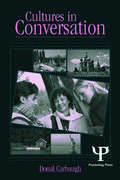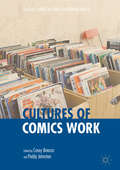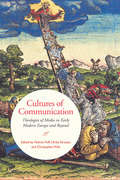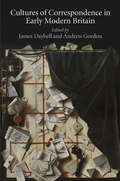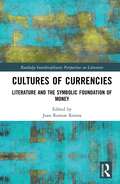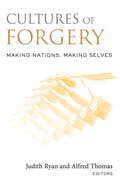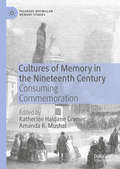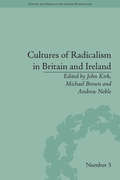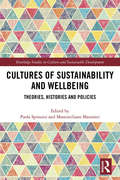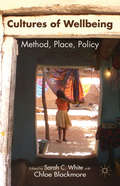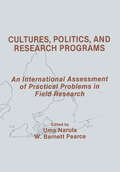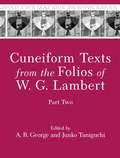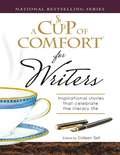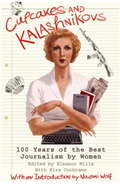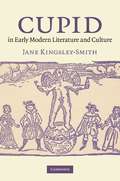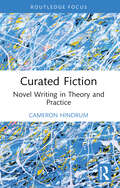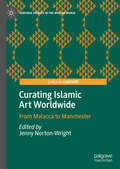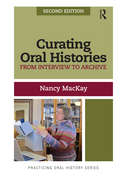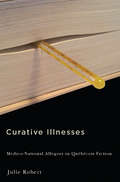- Table View
- List View
Cultures in Contact: Studies in Cross-cultural interaction
by Stephen BochnerAlthough dated, this text presents research regarding cross-cultural interaction.
Cultures in Conversation (Routledge Communication Series)
by Donal CarbaughCultures in Conversation introduces readers to the ethnographic study of intercultural and social interactions through the analysis of conversations in which various cultural orientations are operating. Author Donal Carbaugh presents his original research on conversation practices in England, Finland, Russia, Blackfeet County, and the United States, demonstrating how each is distinctive in its communication codes--particularly in its use of symbolic meanings, forms of interaction, norms, and motivational themes. Examining conversation in this way demonstrates how cultural lives are active in conversations and shows how conversation is a principal medium for the coding of selves, social relationships, and societies. Representing 20 years of research, this volume offers unique insights into the ways social interactions not only gain shape from, but also are formative of cultures. It makes a significant contribution to communication scholarship, and will be illuminating reading in courses focusing on cultural communication, language and social interaction, intercultural pragmatics, and linguistics.
Cultures of Comics Work (Palgrave Studies in Comics and Graphic Novels)
by Casey Brienza Paddy JohnstonThis anthology explores tensions between the individualistic artistic ideals and the collective industrial realities of contemporary cultural production with eighteen all-new chapters presenting pioneering empirical research on the complexities and controversies of comics work. Art Spiegelman. Alan Moore. Osamu Tezuka. Neil Gaiman. Names such as these have become synonymous with the medium of comics. Meanwhile, the large numbers of people without whose collective action no comic book would ever exist in the first place are routinely overlooked. Cultures of Comics Work unveils this hidden, global industrial labor of writers, illustrators, graphic designers, letterers, editors, printers, typesetters, publicists, publishers, distributors, translators, retailers, and countless others both directly and indirectly involved in the creative production of what is commonly thought of as the comic book. Drawing upon diverse theoretical and methodological perspectives, an international and interdisciplinary cohort of cutting-edge researchers and practitioners intervenes in debates about cultural work and paves innovative directions for comics scholarship.
Cultures of Communication: Theologies of Media in Early Modern Europe and Beyond
by Christopher Wild Helmut Puff Ulrike StrasserContrary to the historiographical commonplace “no Reformation without print” Cultures of Communication examines media in the early modern world through the lens of the period’s religious history. Looking beyond the emergence of print, this collection of ground-breaking essays highlights the pivotal role of theology in the formation of the early modern cultures of communication. The authors assembled here urge us to understand the Reformation as a response to the perceived crisis of religious communication in late medieval Europe. In addition, they explore the novel demands placed on European media ecology by the acceleration and intensification of global interconnectedness in the early modern period. As the Christian evangelizing impulse began to propel growing numbers of Europeans outward to the Americas and Asia, theories and practices of religious communication had to be reformed to accommodate an array of new communicative constellations – across distances, languages, cultures.
Cultures of Correspondence in Early Modern Britain (Material Texts)
by James Daybell Andrew GordonThe letter is a powerfully evocative form that has gained in resonance as the habits of personal letter writing have declined in a digital age. But faith in the letter as evidence of the intimate thoughts of individuals underplays the sophisticated ways letters functioned in the past. In Cultures of Correspondence in Early Modern Britain leading scholars approach the letter from a variety of disciplinary perspectives to uncover the habits, forms, and secrets of letter writing. Where material features of the letter have often been ignored by past generations fixated on the text alone, contributors to this volume examine how such elements as handwriting, seals, ink, and the arrangement of words on the manuscript page were significant carriers of meaning alongside epistolary rhetorics. The chapters here also explore the travels of the letter, uncovering the many means through which correspondence reached a reader and the ways in which the delivery of letters preoccupied contemporaries. At the same time, they reveal how other practices, such as the use of cipher and the designs of forgery, threatened to subvert the surveillance and reading of letters.The anxiety of early modern letter writers over the vulnerability of correspondence is testament to the deep dependence of the culture on the letter. Beyond the letter as a material object, Cultures of Correspondence sheds light on textual habits. Individual chapters study the language of letter writers to reveal that what appears to be a personal and unvarnished expression of the writer's thought is in fact a deliberate, skillful exercise in managing the conventions and expectations of the form. If letters were a prominent and ingrained part of the cultural life of the early modern period, they also enjoyed textual and archival afterlives whose stories are rarely told. Too often studied only in the case of figures already celebrated for their historical or literary significance, the letter in Cultures of Correspondence emerges as the most vital and wide-ranging material, textual form of the early modern period.Contributors: Nadine Akkerman, Mark Brayshay, Christopher Burlinson, James Daybell, Jonathan Gibson, Andrew Gordon, Arnold Hunt, Lynne Magnusson, Michelle O'Callaghan, Alan Stewart, Andrew Zurcher.
Cultures of Currencies: Literature and the Symbolic Foundation of Money (Routledge Interdisciplinary Perspectives on Literature)
by Joan Ramon ResinaThis book’s premise is not only the commonly accepted cultural relativity of economic concepts, but also the observation that the current shift in the meaning of concepts like “market,” “currency,” “exchange,” and “money” suggests that culture is undergoing a change with unpredictable economic and political consequences. The essays in the book raise basic questions concerning exchange – what is exchanged, who exchanges and how, which kind of currency is used, and indeed what is money and how does it convey and retain value over time. These issues are all classical objects of economic theory, but less often have they been approached from a cultural perspective. Works treating economic and monetary issues from a cultural perspective are few and far apart, and this book aims to contribute to such a perspective with a variety of approaches.
Cultures of Forgery: Making Nations, Making Selves (CultureWork: A Book Series from the Center for Literacy and Cultural Studies at Harvard)
by Judith Ryan Alfred ThomasIn Cultures of Forgery, leading literary studies and cultural studies scholars examine the double meaning of the word "forge"-to create or to form, on the one hand, and to make falsely, on the other.
Cultures of Memory in the Nineteenth Century: Consuming Commemoration (Palgrave Macmillan Memory Studies)
by Katherine Haldane Grenier Amanda R. MushalThis collection provides a long-overdue examination of the nineteenth century as a crucible of new commemorative practices. Distinctive memory cultures emerged during this period which would fundamentally reshape public and private practices of remembrance in the modern world. The essays in this volume bring together scholars of History, Literature, Art History, and Musicology to explore uses of memory in nineteenth-century empire-building and constructions of national identity, cultures of sentiment and mourning practices, and discourses of race and power. Contributors approach the topic through case studies of Europe, the United States, and the British Empire. Their analyses of nineteenth-century innovations in commemoration at both the personal and the larger civic and political levels will appeal to students and scholars of memory and of the nineteenth-century world.
Cultures of Radicalism in Britain and Ireland (Poetry and Song in the Age of Revolution #3)
by John KirkThis collection of essays addresses the role of literature in radical politics. Topics covered include the legacy of Robert Burns, broadside literature in Munster and radical literature in Wales.
Cultures of Sustainability and Wellbeing: Theories, Histories and Policies (Routledge Studies in Culture and Sustainable Development)
by Paola Spinozzi Massimiliano MazzantiCultures of Sustainability and Wellbeing: Theories, Histories and Policies examines and assesses the interdependence between sustainability and wellbeing by drawing attention to humans as producers and consumers in a post-human age. Why wellbeing ought to be regarded as essential to sustainable development is explored first from multifocal theoretical perspectives encompassing sociology, literary criticism and socioeconomics, second in relation to institutions and policies, and third with a focus on specific case studies across the world. Wellbeing and its sustainability are defined in terms of biological and cultural diversity; stages of advancement in science and technology; notions of citizenship and agency; geopolitical scenarios and environmental conditions. Wellbeing and sustainability call for enquiries into human capacities in ontological, epistemological and practical terms. A view of sustainability that revolves around material and immaterial wellbeing is based on the assumption that life quality, comfort, happiness, security, safety always posit humans as both recipients and agents. Risk and resilience in contemporary societies define the intrinsically human ability to make and consume, to act and adapt, driving the search for and fruition of wellbeing. How to sustain the dual process of exploitation and regeneration is a task that requires integrated approaches from the sciences and the humanities, jointly tracing a worldwide cartography with clear localisations. This book will be of great interest to students and researchers interested in sustainability through conceptual and empirical approaches including social theory, literary and cultural studies, environmental economics and human ecology, urbanism and cultural geography.
Cultures of the Fragment: Uses of the Iberian Manuscript, 1100-1600 (Toronto Iberic)
by Heather BamfordThe majority of medieval and sixteenth-century Iberian manuscripts, whether in Latin, Hebrew, Arabic, Spanish or Aljamiado (Spanish written in Arabic script), contain fragments or are fragments. The term fragment is used to describe not only isolated bits of manuscript material with a damaged appearance, but also any piece of a larger text that was intended to be a fragment. Investigating the vital role these fragments played in medieval and early modern Iberian manuscript culture, Heather Bamford’s Cultures of the Fragment is focused on fragments from five major Iberian literary traditions, including Hispano-Arabic and Hispano-Hebrew poetry, Latin and Castilian epics, chivalric romances, and the literature of early modern crypto-Muslims. The author argues that while some manuscript fragments came about by accident, many were actually created on purpose and used in a number of ways, from binding materials, to anthology excerpts, and some fragments were even incorporated into sacred objects as messages of good luck. Examining four main motifs of fragmentation, including intention, physical appearance, metonymy, and performance, this work reveals the centrality of the fragment to manuscript studies, highlighting the significance of the fragment to Iberia’s multicultural and multilingual manuscript culture.
Cultures of War in Graphic Novels: Violence, Trauma, and Memory
by Tatiana Prorokova Nimrod Tal Iain A. MacInnes Kenton Worcester Emir Pasanovic Harriet E.H. Earle James Kelley Joe Lockard Christina M. Knopf Peter C. Valenti Silvia G. Kurlat Ares Yasmine Nachabe TaanCultures of War in Graphic Novels examines the representation of small-scale and often less acknowledged conflicts from around the world and throughout history. The contributors look at an array of graphic novels about conflicts such as the Boxer Rebellion (1899-1901), the Irish struggle for national independence (1916-1998), the Falkland War (1982), the Bosnian War (1992-1995), the Rwandan genocide (1994), the Israel-Lebanon War (2006), and the War on Terror (2001-). The book explores the multi-layered relation between the graphic novel as a popular medium and war as a pivotal recurring experience in human history. The focus on largely overlooked small-scale conflicts contributes not only to advance our understanding of graphic novels about war and the cultural aspects of war as reflected in graphic novels, but also our sense of the early twenty-first century, in which popular media and limited conflicts have become closely interrelated.
Cultures of Wellbeing: Method, Place, Policy
by Sarah C. White Chloe BlackmoreThe authors challenge psychological perspectives on happiness and subjective wellbeing. Highlighting the politics of quantitative and qualitative methodologies, case studies across continents explore wellbeing in relation to health, children and youth, migration, economics, religion, family, land mines, national surveys, and indigenous identities.
Cultures, Politics, and Research Programs: An International Assessment of Practical Problems in Field Research (Routledge Communication Series)
by Uma Narula W. Barnett PearceA compilation of authoritative reports from seasoned researchers working in eight different countries on five continents, this volume examines the concept that conditions of local feasibility are constitutive of research practices not simply obstructions to the realization of an ideal. The result documents the effects of political and cultural factors on research projects and offers culturally sensitive researchers a wealth of practical knowledge.
Cuneiform Texts from the Folios of W. G. Lambert, Part Two (Mesopotamian Civilizations #25)
by A. R. George, Junko TaniguchiThis book publishes 323 handcopies of cuneiform tablets found in the academic papers of W. G. Lambert (1926–2011), one of the foremost Assyriologists of the twentieth century. Prepared by A. R. George and Junko Taniguchi, it completes a two-part edition of Lambert’s previously unpublished handcopies.Written by Babylonian and Assyrian scribes in ancient Mesopotamia, the texts collected here are organized by genre and presented with a descriptive catalogue and indexes. The contents include omen literature, divinatory rituals, religious texts, a scribal parody of Babylonian scholarship, theological and religious texts, lexical lists, god lists, and a small group of miscellaneous texts of various genres. The tablets are mainly from the British Museum, but some come from museums in Baghdad, Berlin, Chicago, Geneva, Istanbul, Jerusalem, New Haven, Oxford, Paris, Philadelphia, Tokyo, Toronto, and Washington. In addition, there are copies of eight tablets whose current whereabouts are unknown.This third collection of Lambert’s handcopies published by Eisenbrauns—following Babylonian Creation Myths and Cuneiform Texts from the Folios of W. G. Lambert, Part One—is a crucial part of the intellectual history of the field of Assyriology. In addition, many of these texts are published herein for the first time, making them a valuable and important resource for further study.
Cuneiform Texts from the Folios of W. G. Lambert, Part Two (Mesopotamian Civilizations)
by A. R. George, Junko TaniguchiThis book publishes 323 handcopies of cuneiform tablets found in the academic papers of W. G. Lambert (1926–2011), one of the foremost Assyriologists of the twentieth century. Prepared by A. R. George and Junko Taniguchi, it completes a two-part edition of Lambert’s previously unpublished handcopies.Written by Babylonian and Assyrian scribes in ancient Mesopotamia, the texts collected here are organized by genre and presented with a descriptive catalogue and indexes. The contents include omen literature, divinatory rituals, religious texts, a scribal parody of Babylonian scholarship, theological and religious texts, lexical lists, god lists, and a small group of miscellaneous texts of various genres. The tablets are mainly from the British Museum, but some come from museums in Baghdad, Berlin, Chicago, Geneva, Istanbul, Jerusalem, New Haven, Oxford, Paris, Philadelphia, Tokyo, Toronto, and Washington. In addition, there are copies of eight tablets whose current whereabouts are unknown.This third collection of Lambert’s handcopies published by Eisenbrauns—following Babylonian Creation Myths and Cuneiform Texts from the Folios of W. G. Lambert, Part One—is a crucial part of the intellectual history of the field of Assyriology. In addition, many of these texts are published herein for the first time, making them a valuable and important resource for further study.
A Cup of Comfort for Writers
by Colleen SellAs every writer knows, keeping the faith isn't always easy. On those days when you find yourself literally at a loss for words, you may long for a little writer's TLC. In A Cup of Comfort for Writers, you'll meet more than fifty writers who, just like you, have faced down that empty page and won! From a woman who enters an elite writing program at the age of forty, and proceeds to blow "the pros" away, to a man who wins his wife's hand by writing her countless love letters. Whether you're already published or as yet undiscovered, A Cup of Comfort for Writers will inspire you, motivate you, and fuel the fire that keeps you writing.
A Cup of Comfort for Writers: Inspirational Stories that Celebrate the Literary Life
by Colleen SellAs every writer knows, keeping the faith isn't always easy. On those days when you find yourself literally at a loss for words, you may long for a little writer's TLC. In A Cup of Comfort for Writers, you'll meet more than fifty writers who, just like you, have faced down that empty page and won! From a woman who enters an elite writing program at the age of forty, and proceeds to blow "the pros" away, to a man who wins his wife's hand by writing her countless love letters. Whether you're already published or as yet undiscovered, A Cup of Comfort for Writers will inspire you, motivate you, and fuel the fire that keeps you writing.
Cupcakes and Kalashnikovs: 100 years of the best Journalism by women
by Eleanor MillsMany female journalists came to the fore during the first and second world wars, and their perspective was very different to that of their male peers, who were reporting from the field. Specifically, they often wrote about war from the perspective of those left at home, struggling to keep the household afloat. And with 'How it feels to be forcibly fed' (1914) by Djuna Barnes, one of the world's very first experiential, or 'gonzo' journalists, came a new age of reporting.Since then, women have continued to break new ground in newspapers and magazines, redefining the world as we see it. Many of the pieces here feel almost unsettlingly relevant today -- the conclusions Emma 'Red' Goldman drew in her 1916 'The social aspects of birth control', Maddy Vegtel's 1930s article about becoming pregnant at 40, Eleanor Roosevelt's call for greater tolerance after America's race riots in 1943. Many have pushed other limits: Naomi Wolf's Beauty Myth brought feminism to a new generation; Helen Fielding's Bridget Jones caused a media revolution; Ruth Picardie's unflinchingly honest column about living with cancer in 1997 brought a wave of British candour and a host of imitators; and when two iconic women come face to face, we have at one end Dorothy Parker on Isadora Duncan (1928) and at the other Julie Burchill on Margaret Thatcher (2004). This collection of superlative writing, selected by the Sunday Times's most senior female editor, brings together the most influential, incisive, controversial, affecting and entertaining pieces of journalism by the best women in the business. Covering: War; Crime; Politics & Society; Sex & Romance; Body Image & Health; Family, Friendship & Birth; Emancipation & Having it All; Hearth & Home; Icons & Interviews. Including: Lynn Barber, Djuna Barnes, Julie Burchill, Angela Carter, Marie Colvin, Jilly Cooper, Joan Didion, Margaret Drabble, Helen Fielding, Zelda Fitzgerald, Kathryn Flett, Martha Gellhorn, Nicci Gerrard, Emma Goldman, Germaine Greer, Nicola Horlick, Erica Jong, Jamaica Kincaid, India Knight, Christina Lamb, Daphne du Maurier, Nancy Mitford, Suzanne Moore, Camille Paglia, Sylvia Pankhurst, Dorothy Parker, Allison Pearson, Ruth Picardie, Erin Pizzey, Eleanor Roosevelt, Zadie Smith, Susan Sontag, Gloria Steinem, Martha Stewart, Mary Stott, Jill Tweedie, Rebecca West, Zoe Williams, Jeanette Winterson, Naomi Wolf.
Cupcakes and Kalashnikovs: 100 Years Of The Best Journalism By Women
by Naomi Wolf Eleanor MillsMany female journalists came to the fore during the first and second world wars, and their perspective was very different to that of their male peers, who were reporting from the field. Specifically, they often wrote about war from the perspective of those left at home, struggling to keep the household afloat. And with 'How it feels to be forcibly fed' (1914) by Djuna Barnes, one of the world's very first experiential, or 'gonzo' journalists, came a new age of reporting.Since then, women have continued to break new ground in newspapers and magazines, redefining the world as we see it. Many of the pieces here feel almost unsettlingly relevant today -- the conclusions Emma 'Red' Goldman drew in her 1916 'The social aspects of birth control', Maddy Vegtel's 1930s article about becoming pregnant at 40, Eleanor Roosevelt's call for greater tolerance after America's race riots in 1943. Many have pushed other limits: Naomi Wolf's Beauty Myth brought feminism to a new generation; Helen Fielding's Bridget Jones caused a media revolution; Ruth Picardie's unflinchingly honest column about living with cancer in 1997 brought a wave of British candour and a host of imitators; and when two iconic women come face to face, we have at one end Dorothy Parker on Isadora Duncan (1928) and at the other Julie Burchill on Margaret Thatcher (2004). This collection of superlative writing, selected by the Sunday Times's most senior female editor, brings together the most influential, incisive, controversial, affecting and entertaining pieces of journalism by the best women in the business. Covering: War; Crime; Politics & Society; Sex & Romance; Body Image & Health; Family, Friendship & Birth; Emancipation & Having it All; Hearth & Home; Icons & Interviews. Including: Lynn Barber, Djuna Barnes, Julie Burchill, Angela Carter, Marie Colvin, Jilly Cooper, Joan Didion, Margaret Drabble, Helen Fielding, Zelda Fitzgerald, Kathryn Flett, Martha Gellhorn, Nicci Gerrard, Emma Goldman, Germaine Greer, Nicola Horlick, Erica Jong, Jamaica Kincaid, India Knight, Christina Lamb, Daphne du Maurier, Nancy Mitford, Suzanne Moore, Camille Paglia, Sylvia Pankhurst, Dorothy Parker, Allison Pearson, Ruth Picardie, Erin Pizzey, Eleanor Roosevelt, Zadie Smith, Susan Sontag, Gloria Steinem, Martha Stewart, Mary Stott, Jill Tweedie, Rebecca West, Zoe Williams, Jeanette Winterson, Naomi Wolf.
Cupid in Early Modern Literature and Culture
by Jane Kingsley-SmithCupid became a popular figure in the literary and visual culture of post-Reformation England. He served to articulate and debate the new Protestant theory of desire, inspiring a dark version of love tragedy in which Cupid kills. But he was also implicated in other controversies, as the object of idolatrous, Catholic worship and as an adversary to female rule: Elizabeth I's encounters with Cupid were a crucial feature of her image-construction and changed subtly throughout her reign. Covering a wide variety of material such as paintings, emblems and jewellery, but focusing mainly on poetry and drama, including works by Sidney, Shakespeare, Marlowe and Spenser, Kingsley-Smith illuminates the Protestant struggle to categorise and control desire and the ways in which Cupid disrupted this process. An original perspective on early modern desire, the book will appeal to anyone interested in the literature, drama, gender politics and art history of the English Renaissance.
Curated Fiction: Novel Writing in Theory and Practice
by Cameron HindrumCurated Fiction presents a new theory and methodology for developing, drafting and refining creative writing. At the intersection of literary studies and creative writing, this book develops a new theory for analysing how novelists use narrative point-of-view to direct readers’ trust.The book defines the parameters and practice of one possible approach to the creative development of a work of long-form fiction. The value underpinning this approach will be drawn from the theories that inform it, such as Irene Kacandes’s work on Talk Fiction, Bakhtinian concepts of polyphony and Gerald Prince’s concept of the Disnarrated.Offering critical analyses of existing literary works, such as Waterland and As I Lay Dying, Curated Fiction will afford examination of theory in practice, in differing literary forms and contexts before making practical connections with the craft of writing through the analysis of an original short story, 'Foxes'.
Curating Islamic Art Worldwide: From Malacca to Manchester (Heritage Studies in the Muslim World)
by Jenny Norton-WrightThis volume gives voice to cultural institutions working with collections of Islamic art and material culture globally, including many from outside Western Europe and North America. The contributions inform a vibrant, ongoing global conversation around curatorship in this field, one that embraces the responsibilities, challenges and opportunities for those engaged in it. Contributors—including art historians, curators and education specialists—discuss curatorial methodologies in theoretical and practical terms, present new exhibitions of Islamic art and culture, and explore the role of educational and engagement practices related to Islamic collections and Muslim audiences.
Curating Oral Histories: From Interview to Archive (Practicing Oral History #2)
by Nancy MacKayFor the past ten years, Nancy MacKay’s Curating Oral Histories (2006) has been the one-stop shop for librarians, curators, program administrators, and project managers who are involved in turning an oral history interview into a primary research document, available for use in a repository. In this new and greatly expanded edition, MacKay uses the life cycle model to map out an expanded concept of curation, beginning with planning an oral history project and ending with access and use. The book:-guides readers, step by step, on how to make the oral history “archive ready”;-offers strategies for archiving, preserving, and presenting interviews in a digital environment;-includes comprehensive updates on technology, legal and ethical issues, oral history on the Internet, cataloging, copyright, and backlogs.
Curative Illnesses
by Julie RobertDuring a time of uncertainty over collective identity and social transformation, Quebec novels started getting sick - after 1940, the number of narratives about illness, disease, and sick characters intensified. For the last seventy years, generations of authors have turned to medically oriented stories to represent day to day life and political turmoil. In Curative Illnesses, Julie Robert investigates how the theme of sickness is woven into literature and gauges its effect on depictions of Quebec's national identity. Challenging the legitimacy of illness as a metaphor for the nation, Robert contests interpretations of illness-related literature that have presented Quebec itself as ailing. Through re-examinations of Quebec novels, Curative Illnesses shatters the illusion of congruency between the nation and the body, countering assumptions about nationwide weakness and victimization. For Quebec in particular, these assumptions have greater implications, because the separatist movement, policies of interculturalism, and majority language rights revolve around protecting and defending Québécois society and its cultural values. Robert skilfully demonstrates a more nuanced view of illness through a series of analyses focusing on works of literature from some of Quebec's most renowned novelists, including Gabrielle Roy, André Langevin, Denis Lord, Hubert Aquin, Jacques Godbout, Pierre Billon, and Anne Bernard. Using an interdisciplinary approach that engages with nationalism, postcolonial studies, literature, rhetoric, and the medical humanities, Curative Illnesses explores how moving beyond earlier diagnoses offers new insights into nationhood.

